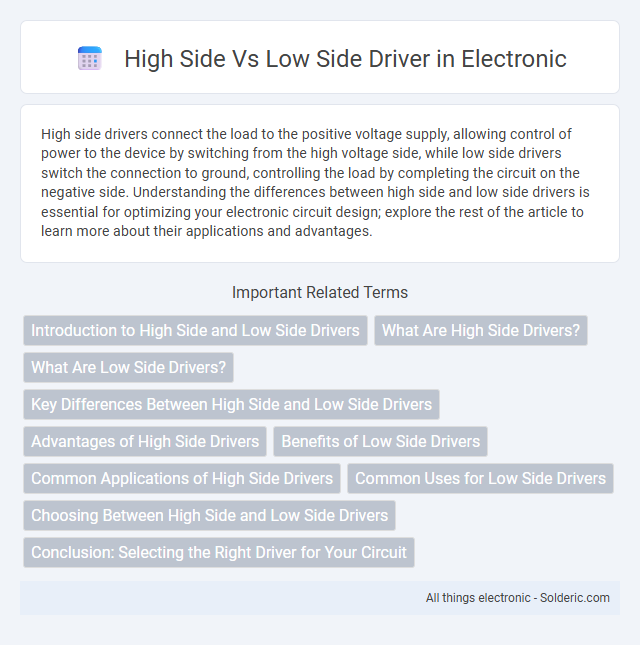High side drivers connect the load to the positive voltage supply, allowing control of power to the device by switching from the high voltage side, while low side drivers switch the connection to ground, controlling the load by completing the circuit on the negative side. Understanding the differences between high side and low side drivers is essential for optimizing your electronic circuit design; explore the rest of the article to learn more about their applications and advantages.
Comparison Table
| Feature | High-Side Driver | Low-Side Driver |
|---|---|---|
| Switching Position | Connects load to positive supply (V+) | Connects load to ground (GND) |
| Load Reference | Load referenced to ground | Load referenced to positive supply |
| Common Usage | Automotive, motor control, high-voltage switching | Standard switching, LED control |
| Complexity | More complex driver circuit | Simple driver circuit |
| Switching Device | Typically P-Channel MOSFET or PNP transistor | Typically N-Channel MOSFET or NPN transistor |
| Voltage Level Referencing | Driver referenced to load-side voltage | Driver referenced to ground |
| Protection | Better protection against ground noise | Less protection, susceptible to ground noise |
| Cost | Generally higher cost | Generally lower cost |
Introduction to High Side and Low Side Drivers
High side and low side drivers control power flow in electronic circuits by switching the voltage supply or ground path, respectively. High side drivers connect the load to the positive voltage rail, enabling control of devices requiring a positive supply, while low side drivers switch the ground connection, effectively pulling the load to ground. Both types are essential for managing current flow in applications like motor control, LED driving, and power management systems.
What Are High Side Drivers?
High side drivers control the power supply by connecting the load to the positive voltage rail, allowing current to flow from the supply to the load. They are commonly used in automotive and industrial applications for switching power to devices connected to the ground. High side drivers offer protection features such as overcurrent, short circuit, and thermal shutdown, ensuring reliable operation in harsh environments.
What Are Low Side Drivers?
Low side drivers control electrical loads by switching the connection to ground, allowing current to flow through the load when activated. These drivers are commonly used in automotive and industrial applications for switching devices such as relays, LEDs, and motors, offering straightforward design and cost-effectiveness. Understanding your system's voltage and load requirements helps determine when a low side driver is the best choice for efficient and reliable operation.
Key Differences Between High Side and Low Side Drivers
High side drivers connect the load to the positive voltage supply, enabling control by switching the supply voltage, while low side drivers connect the load to ground, switching the ground path instead. High side drivers are preferred for applications requiring load switching on the positive rail, providing better protection against ground faults and easier integration with microcontrollers operating at a common ground. Low side drivers offer simpler design and cost-effectiveness but may cause issues with ground reference and are less suitable for certain inductive loads due to potential ground disturbances.
Advantages of High Side Drivers
High side drivers provide the advantage of easier switching in automotive and industrial applications by controlling the positive voltage side, reducing voltage drops and enhancing load protection. This configuration allows for better load isolation and improved safety, as the circuit remains grounded, minimizing the risk of short circuits. Your system benefits from increased durability and stability when using high side drivers in high-current or high-voltage environments.
Benefits of Low Side Drivers
Low side drivers offer simplified circuit design, making them easier to implement and troubleshoot in various applications. They provide efficient grounding control and reduce complexity by switching the load's connection to ground instead of the power supply. Your system benefits from increased reliability and cost-effectiveness when using low side drivers due to their straightforward operation and lower risk of voltage spikes.
Common Applications of High Side Drivers
High side drivers are commonly used in automotive and industrial applications for controlling power to loads such as motors, lamps, and valves, where switching the positive voltage supply is essential. They provide protection against short circuits and overloads, making them ideal for driving inductive loads in battery-powered systems. High side drivers also enable simplified wiring and improved system diagnostics by integrating features like current sensing and diagnostics feedback.
Common Uses for Low Side Drivers
Low side drivers are commonly used for switching ground connections in automotive lighting, motor control, and LED applications due to their simplicity and cost-effectiveness. They enable stable control of loads by switching the negative side, making them ideal for devices requiring reliable grounding without affecting the positive voltage supply. Your electronic design benefits from low side drivers when managing devices that need straightforward on/off switching with minimal complexity.
Choosing Between High Side and Low Side Drivers
Choosing between high side and low side drivers depends on the specific circuit requirements, such as voltage levels, load type, and safety considerations. High side drivers are ideal for switching the positive supply line, offering better protection and easier interfacing with microcontrollers in high voltage applications. Low side drivers switch the ground line, providing simpler implementation but less protection against voltage spikes and potential grounding issues.
Conclusion: Selecting the Right Driver for Your Circuit
Choosing between a high side and low side driver depends on your circuit requirements, such as load type, voltage levels, and grounding preferences. High side drivers are ideal for controlling loads connected to the positive voltage rail, offering better load isolation and safety for your system. Low side drivers simplify design and cost, especially when switching the negative side, but may introduce grounding challenges depending on your setup.
high side vs low side driver Infographic

 solderic.com
solderic.com